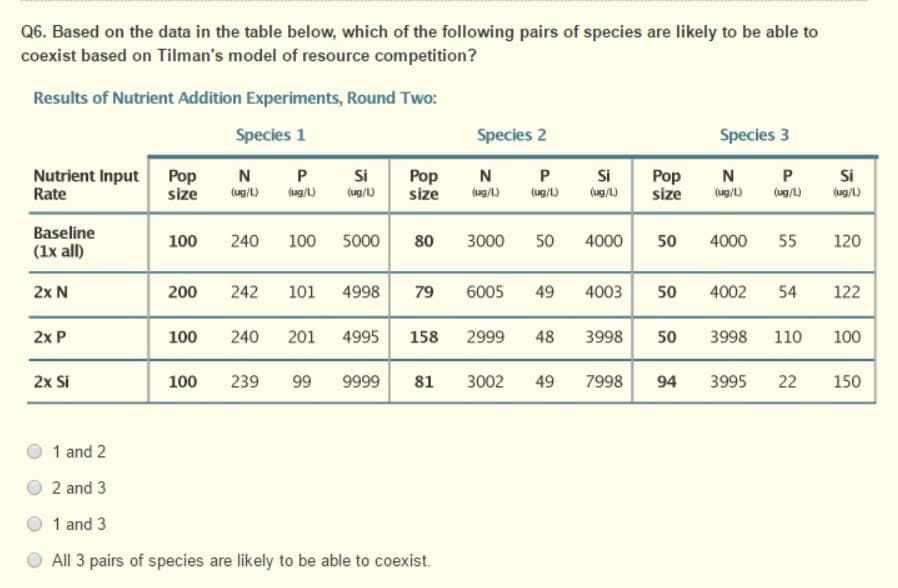Q6. Based on the data in the table below, which of the following pairs of species are likely to be able to coexist based on Tilman's model of resource competition? Results of Nutrient Addition Experiments, Round Two: Species 1 Species 2 Species 3 Nutrient Input Rate Pop size N P ug/) Si Pop N P Si (ug/) Pop size N P Si (ug/) size (ug/L) (ug/) ug/) (ug/) (ug/) Baseline (1x all) 100 240 100 5000 80 3000 50 4000 50 4000 55 120 2x N 200 242 101 4998 79 6005 49 4003 50 4002 54 122 2x P 100 240 201 4995 158 2999 48 3998 50 3998 110 100 2x Si 100 239 99 9999 81 3002 49 7998 94 3995 22 150 1 and 2 2 and 3 1 and 3 All 3 pairs of species are likely to be able to coexist.
Q6. Based on the data in the table below, which of the following pairs of species are likely to be able to coexist based on Tilman's model of resource competition? Results of Nutrient Addition Experiments, Round Two: Species 1 Species 2 Species 3 Nutrient Input Rate Pop size N P ug/) Si Pop N P Si (ug/) Pop size N P Si (ug/) size (ug/L) (ug/) ug/) (ug/) (ug/) Baseline (1x all) 100 240 100 5000 80 3000 50 4000 50 4000 55 120 2x N 200 242 101 4998 79 6005 49 4003 50 4002 54 122 2x P 100 240 201 4995 158 2999 48 3998 50 3998 110 100 2x Si 100 239 99 9999 81 3002 49 7998 94 3995 22 150 1 and 2 2 and 3 1 and 3 All 3 pairs of species are likely to be able to coexist.
Biology: The Unity and Diversity of Life (MindTap Course List)
14th Edition
ISBN:9781305073951
Author:Cecie Starr, Ralph Taggart, Christine Evers, Lisa Starr
Publisher:Cecie Starr, Ralph Taggart, Christine Evers, Lisa Starr
Chapter44: Population Ecology
Section: Chapter Questions
Problem 13SQ: Match each term with its most suitable description. _____ carrying capacity a. maximum rate or...
Related questions
Question

Transcribed Image Text:Q6. Based on the data in the table below, which of the following pairs of species are likely to be able to
coexist based on Tilman's model of resource competition?
Results of Nutrient Addition Experiments, Round Two:
Species 1
Species 2
Species 3
Nutrient Input
Rate
Pop
size
N P Si
Pop
size
Si
Si
(ug/L)
P
N
(ug/L)
Pop
size
N
(ug/D
(ug/L)
(ug/L)
(ug/)
(ug/L)
(ug/)
(ug/)
Baseline
100
240
100
5000
80
3000
50
4000
50
4000
55
120
(1x all)
2x N
200
242
101
4998
79
6005
49
4003
50
4002
54
122
2x P
100
240
201
4995
158
2999
48
3998
50
3998
110
100
2x Si
100
239
99
9999
81
3002
49
7998
94
3995
22
150
1 and 2
2 and 3
1 and 3
All 3 pairs of species are likely to be able to coexist.
Expert Solution
This question has been solved!
Explore an expertly crafted, step-by-step solution for a thorough understanding of key concepts.
This is a popular solution!
Trending now
This is a popular solution!
Step by step
Solved in 2 steps

Knowledge Booster
Learn more about
Need a deep-dive on the concept behind this application? Look no further. Learn more about this topic, biology and related others by exploring similar questions and additional content below.Recommended textbooks for you

Biology: The Unity and Diversity of Life (MindTap…
Biology
ISBN:
9781305073951
Author:
Cecie Starr, Ralph Taggart, Christine Evers, Lisa Starr
Publisher:
Cengage Learning

Biology: The Unity and Diversity of Life (MindTap…
Biology
ISBN:
9781337408332
Author:
Cecie Starr, Ralph Taggart, Christine Evers, Lisa Starr
Publisher:
Cengage Learning


Biology: The Unity and Diversity of Life (MindTap…
Biology
ISBN:
9781305073951
Author:
Cecie Starr, Ralph Taggart, Christine Evers, Lisa Starr
Publisher:
Cengage Learning

Biology: The Unity and Diversity of Life (MindTap…
Biology
ISBN:
9781337408332
Author:
Cecie Starr, Ralph Taggart, Christine Evers, Lisa Starr
Publisher:
Cengage Learning


Biology: The Dynamic Science (MindTap Course List)
Biology
ISBN:
9781305389892
Author:
Peter J. Russell, Paul E. Hertz, Beverly McMillan
Publisher:
Cengage Learning